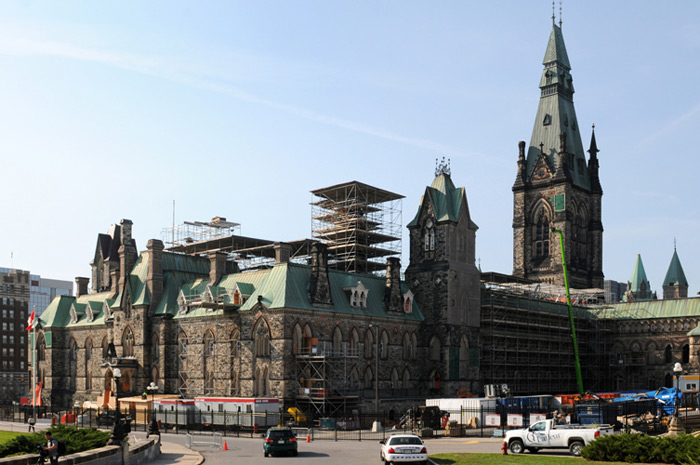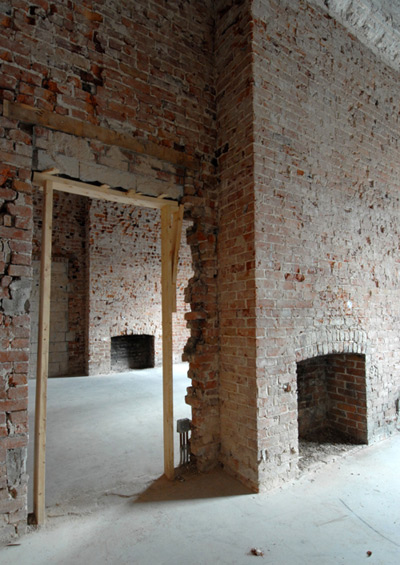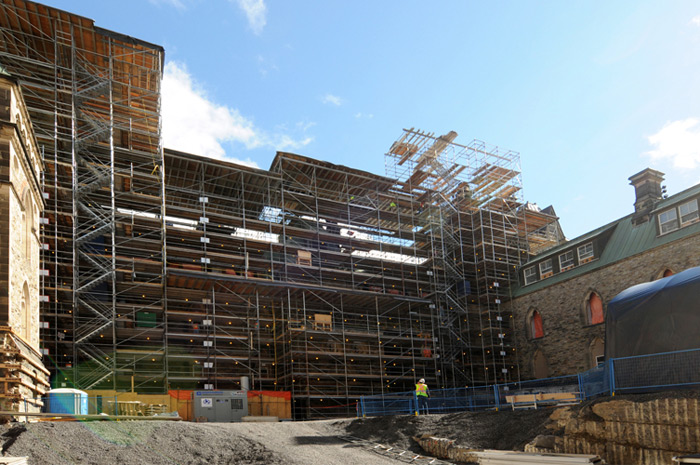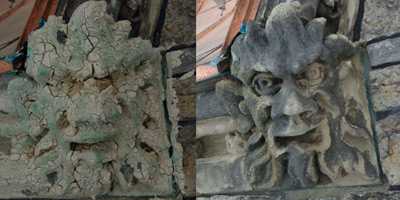Preserving Canada's heritage, one stone at a time
November 2012
 Work is proceeding on schedule as PWGSC embarks on the next phase of the rehabilitation of the West Block—repairs to the building's masonry. (Photo courtesy of Ron de Vries Photography)
Work is proceeding on schedule as PWGSC embarks on the next phase of the rehabilitation of the West Block—repairs to the building's masonry. (Photo courtesy of Ron de Vries Photography)A new chapter has begun in the West Block rehabilitation project: Work to repair the deteriorating masonry of this Gothic Revival building started this fall.
In order to preserve this historic building—which, having opened in 1865, is two years older than Canada itself—the structural integrity of the masonry must be fully restored, and the seismic capabilities of the structure must be upgraded.
 Demolition of the pre-Confederation building's interior is almost complete. (Photo courtesy of Ron de Vries Photography)
Demolition of the pre-Confederation building's interior is almost complete. (Photo courtesy of Ron de Vries Photography)“We're excited to embark on the next phase of this project to preserve this heritage building for future generations and to provide a workplace for our country's parliamentarians,” said Pierre-Marc Mongeau, Assistant Deputy Minister of the Parliamentary Precinct Branch.
If you have visited the site, you will have noticed that scaffolding has started to go up around the building in preparation for the masonry work that began in the fall. The scaffolding will cover the full height of the building in sections, including the copper roofs, and the area will be fully covered by tarps and heated during the winter to allow workers to operate year-round.
The first stage of masonry work will begin in the courtyard and is a critical step in the West Block rehabilitation project. The masonry repairs are critical to preserving the building since the masonry of the courtyard's exterior walls must be fully restored and stabilized before the construction of the permanent infill can begin.
These heritage walls, to be repaired by hand, will eventually surround the temporary House of Commons chamber that will be located in the courtyard of the West Block.
“An interesting aspect of the project is that we are combining the use of advanced technological equipment for investigative work with old-world techniques for masonry and roofing. It is great to see so many trades and professional specialists take part in this heritage project,” said Ezio DiMillo, Director General, Major Crown Projects, Parliamentary Precinct Branch.
A great deal of work has already begun, with heritage masons having started inspecting the condition of the masonry in September. Demolition of the interior of the West Block is nearly complete, and preliminary masonry repairs have started in the interior of the east wing in areas that are cracked, or where seismic upgrades are required. These repairs will provide valuable information about the masonry work required in the remainder of the interior, which will start after the demolition work is completed.
In 2008 and 2011, the southeast tower and the north towers, which were the least stable areas of the building, were repaired as pilot projects. These projects provided valuable information that will now be applied to the restoration and reinforcement of the overall structure. As part of these projects, heritage stone masons inspected and cleaned all of the stones, and, if they were badly damaged, replaced them. The masons also installed steel anchors and injected grout to reinforce and unify the layers of stones. The same process will now be applied to the whole building to ensure its life is extended well beyond the 21st-century.
The work will be done using traditional techniques and tools, such as hand chisels, to ensure that the repairs maintain the building's original architectural character. Limestone from Nepean, Ontario, and sandstone from Ohio—the same stone originally used in the construction of the Parliament Buildings—will be used in the rehabilitation of the masonry.
The masonry work is scheduled to be completed in 2016.
Learn more about the rehabilitation of the Parliamentary Precinct.
 An intricate maze of scaffolding was installed in the West Block's courtyard, where the rehabilitation of the masonry began. (Photo courtesy of Ron de Vries Photography)
An intricate maze of scaffolding was installed in the West Block's courtyard, where the rehabilitation of the masonry began. (Photo courtesy of Ron de Vries Photography) - Date modified:
 Did you know that conservators have been busy repairing the West Block's hundreds of elaborate stone carvings? Grotesques—fanciful and playful carvings—have been cleaned up using a poultice made of water and fine dust. This solution is used to remove almost 150 years of smoke and other airborne pollutants, as well as copper and iron stains, which obscure the details of these intricate carvings.
Did you know that conservators have been busy repairing the West Block's hundreds of elaborate stone carvings? Grotesques—fanciful and playful carvings—have been cleaned up using a poultice made of water and fine dust. This solution is used to remove almost 150 years of smoke and other airborne pollutants, as well as copper and iron stains, which obscure the details of these intricate carvings.